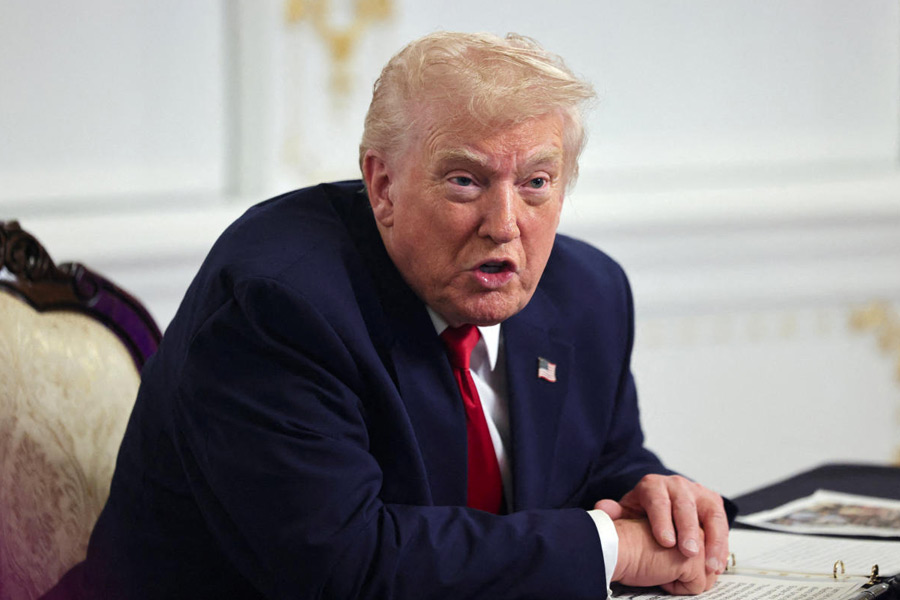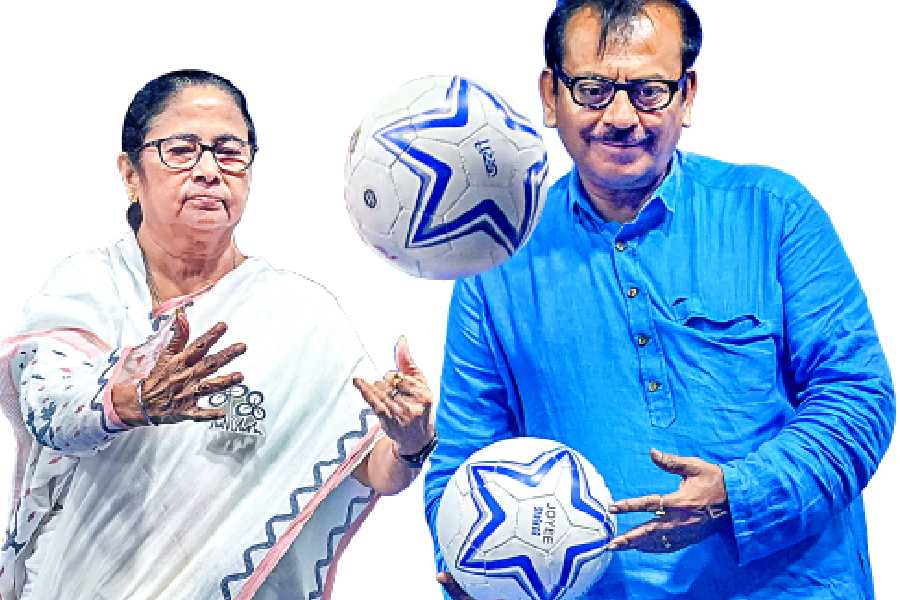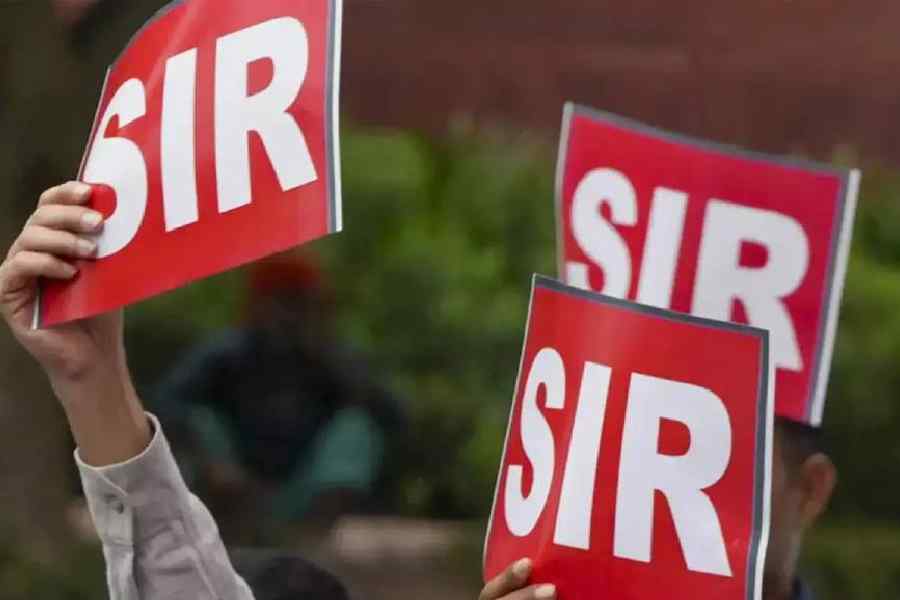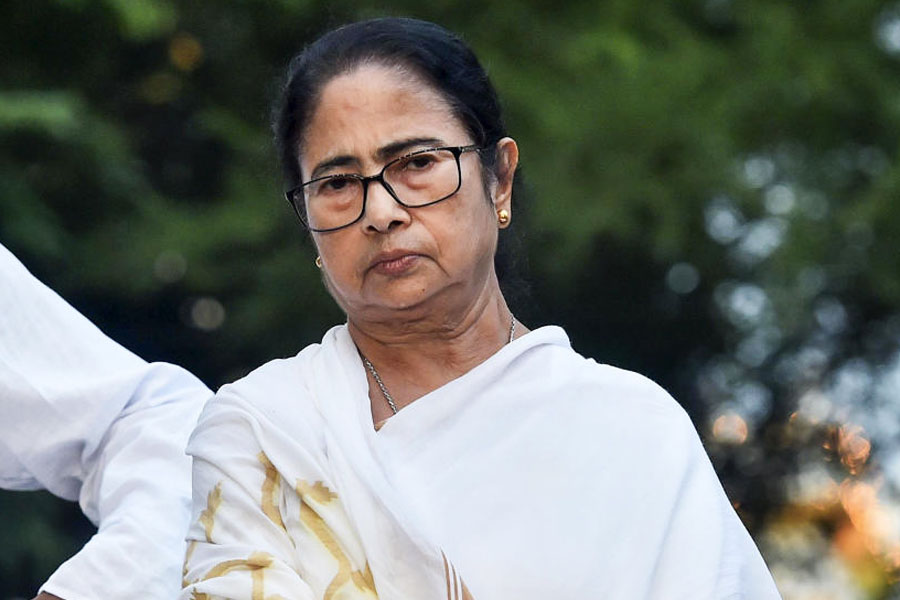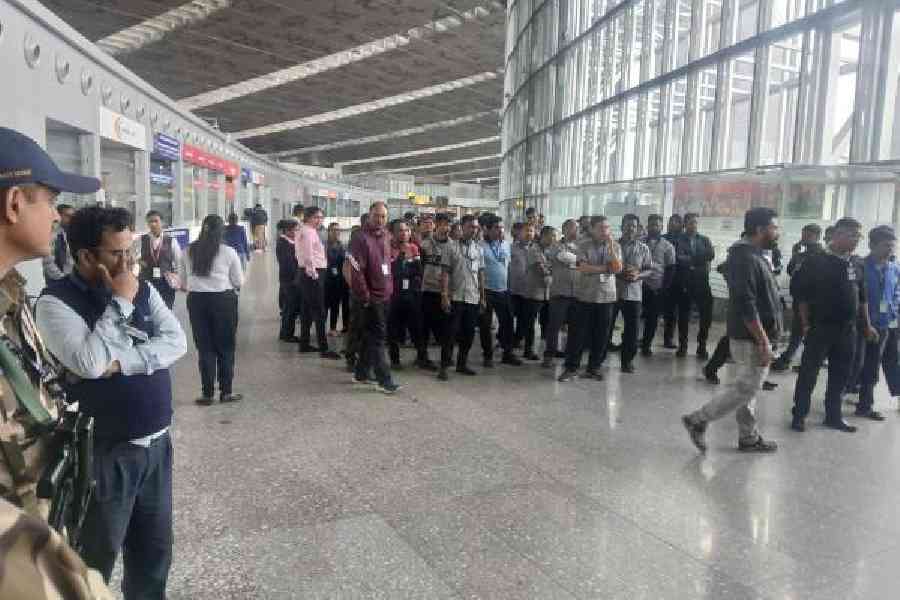 |
 |
 |
 |
| (From top) Ravi Shankar the superstar; Ravi Shankar the disciple at the feet of ‘baba’ ustad allauddin khan; ‘dada’ uday shankar the legend; Ravi Shankar the guru with ‘ghora’ tanmoy bose |
When I think of him as Pandit Ravi Shankar, I feel a certain pressure building up in the back of my mind. But when I think of going back to Jethamoshai and being his Ghora (that’s what he calls me fondly), it’s great fun.
He will never weigh you down with his legacy or the fact that he is a Bharat Ratna, and recipient of all the world’s greatest honours. Easy-going, fun-loving and much younger than me even at 91, he loves to play with words and is fluent in several languages.
He will welcome me and flood me with questions about Calcutta the moment I walk in.... The latest play, new films, new book releases, lyricists, young musicians — a quick update on the city he loves so much.
Since last year Chinnama (Ravi Shankar’s wife Sukanya) started video-recording Jethamoshai because whenever I’m with him, either in the studio or travelling on the tour bus, he spends hours chatting about so many interesting things. He talks about the different phases of his life and music. I have spent some great moments with him and Chinnama on the road. His contribution in spreading Indian music in the West, playing for sold-out symphony halls and festivals in every corner of the world, introducing new forms of tantra kari (forms of instrumental nuances), his compositions, film scores, sitar concertos, ballets, orchestras, his humility and tehzeeb... makes him the legend that he is.
So when t2 came up with the idea of a freewheeling chat with Raviji, asking him for an interview was not a difficult task. On a free day during our three-week UK tour this summer, when once again the Barbican Centre was sold out, I went over to Jethamoshai’s beautiful new apartment on Narrow Street overlooking the East London skyline and the river Thames as the backdrop, and sat down for another long conversation, this time for t2…
Jethamoshai, did you always want to play the sitar?
I started learning from Baba (Ustad Allauddin Khan) in 1936 but that was for a short period when he was touring with us in Dada’s (Uday Shankar) troupe. He came to Europe for a year to do a 15-minute solo item in the programme. We toured all over Europe and during that period, in the summer of 1936, I started taking regular taaleem from him when we were in Dartington Hall for two months.
Till then I was playing the sarod, dilruba, esraj, flute, banging a little drum also, but nothing very serious. This is how I grew up till I was 15. I was more into dance. Baba started me with proper exercises… palta, simple gats, bandishes, different ragas and he taught me a lot of songs. Then he came away and we continued our tour in America. After about a year and a half when the war (World War II) started, my brother decided to come back to India and start his centre in Almora. So we came back to India in spring. By then I had decided that I’d go to Baba in Maihar. He had told me that ‘if you want to learn properly you have to come to me’. And that’s what I did. In July 1938, I arrived at Baba’s home in Maihar.
What was his reaction?
Before that Baba used to rebuke me: ‘Oh, you’re like a butterfly! You have long hair, you wear all these dresses and perfumes and you are running after girls’.
So I shaved my head and threw away all my expensive clothes and suits from London’s Savile Row. I took one blanket, a bedsheet, one pillow and some white kurta pyjamas in a tin trunk. He couldn’t recognise me. He saw me and exclaimed, ‘Ita ke re? Ay ki korso?’ (Who is this? What have you done?) But I knew he was happy. I had wanted to please him and it took a great effort on my part — after being totally spoilt, enjoying life and travelling the world — to leave everything. So you can imagine what strong will power I had!
Tell us about your initial days of learning the sitar and developing your own style…
Along with the sitar, I had started my taaleem on surbahar with traditional alaap, jod, jhala with all the angas as played on bin, rabab and sursringar according to the Senia Gharana. I had a simple sitar with round tumbaa and taraf. At that time, I can’t tell you how many different types of sitars were in vogue! There were flat tumbaas with taraf, without taraf, big, medium and very small sizes. It was really very confusing because you had to choose one.
About developing my own style, it was very natural that, with Baba’s great taaleem and also all the influences of music in my growing-up years, my music would have a clear and unique identity. I would also like to mention here that I was greatly influenced by the Carnatic style of music and incorporated the approach to layakari. I also introduced for the first time Carnatic ragas like Kirwani, Charukeshi, Vachaspati, Simhendra Madhyamam, Malaya Marutham and a host of others by performing them in my concerts. I also introduced the new notation system of writing music with Roman letters which most musicians are adapting now. I also introduced the two-hook system to hold the base strings Sa and Pa while playing fast passages to avoid the disturbing resonance from the base strings.
 |
How did you switch from playing on a surbahar to a sitar?
Surbahar was limited to alaap jod and jhala and I wanted an instrument where I wanted to play the whole gamut of alaap, jod, jhala, gat, toda, thumri and dhun, etc.
Where would you get your sitars from?
I have had several sitars from the time I started playing.The first sitar, which I ordered and got made for myself, was from Baba’s younger brother Ustad Ayat Ali Khan. He made me a sitar which had a flat tumba without any taraf. It sounded very good. The next sitar I had was a large one with a flat tumbaa almost like a surbahar, made by Ustad Yusuf Ali Khan (a great sitar player himself) from Lucknow.
How did you arrive at the perfect Ravi Shankar sitar?
I wanted to have a sitar on which I could play all the angas in Dhrupad and Dhamar style as well as gat, taan, toda and jhala as played on sitar. Luckily, after a lot of searching, I got what I wanted from Kanailal of Calcutta in early 1944. It had the base kharaj and kharaj pancham. Nodu Mullick was an amateur instrument maker who became a good friend and was touring with me as tanpura player all over the world till the early ’80s. He took good care of my sitars and improved the sound. From the early ’60s I played on sitars made by him for many years.
I wanted to play the whole range of alaap to thumri on a normal-size sitar, which started with the sitar from Kanailal adding the pancham and kharaj strings.
 |
What is the significance of the upper tumbaa?
Logically or scientifically, the upper tumbaa has the effect of a speaker or making the sound a little round and I used it for many, many years. Then I felt, with the use of good microphones, it was not necessary and it also made the sitar very bulky.
Do you remember your first public performance?
I performed at the age of 11 in Paris as a dancer and musician and playing on all those instruments without any training (laughs). I performed both in Europe and the US. It was wonderful to see my name as a performer in the Carnegie Hall archives from that period!
Tell us about the story of Mr Sitar…
Initially, while touring I would never use a box for my sitar. I would put the sitar in a waterproof material. I also bought a ticket for it as Mr Sitar or Sitar Shankar and carried it next to me! Now I have good boxes specially ordered in Los Angeles.
You’ve always believed that the first superstar of India was your brother Udayji…
The saddest thing you know, Tanmoy, is that my brother has not been properly recognised for his contributions to the world of dance. He laid the foundation of creativity in something which was so Indian. He never grafted or aped the West. Do you know he got a painting diploma in London? Dada’s main inspiration came from Ellora, Ajanta, Mahabalipuram etc, and being a painter he had all the visuals in his mind…. He would spend time sitting in those caves and could visualise the movements. He could see them dance. And with training of Kathakali and inspired by Manipuri, Chhau and different folk and aboriginal dances of India he introduced a completely new style of dance with ancient elements.
He also took the best from the West in way of presentation because he was in London for so many years. My father, Dr Shyam Shankar, was the first Indian to produce an Indian ballet — a fantasy called Dreams of Abu Hussain — in Covent Garden in 1924. He had asked Dada to work out the dancing styles because he knew that Dada was watching a lot of dance of different forms.
So Dada got to do some dancing and by chance Anna Pavlova came to watch the show with Sir William Rothenstein who was Dada’s painting teacher. Pavlova was very impressed. She had been to India in the 1920s where she saw a lot of dance and she wanted to do something with an Indian element.
After the performance she told Sir William Rothenstein ‘I want this young man’. So Dada joined her troupe and toured all over Europe, North and South America for two years. He got the chance to choreograph two ballets — Radha Krishna where Pavlova played Radha and Dada was Krishna. The other one was a scene from an Indian marriage. They were very successful but after two years Dada had visions of doing something bigger and purer on his own. So he left and came to India. That’s when I saw him for the first time. I was nine years old then.
So you had never seen your Dada before that?
No. He had left India when I was only three months old. He saw me after I was born and then went off to London with my father.
Was it in Paris that you had your first brush with the performing arts?
In Paris, I was in the world of music and dance all of a sudden. It was a wonderful period. That was the time I met personalities like Romain Rolland, Sylvain Levi, Cole Porter, Gertrude Stein, Pablo Casals and a host of others. Paris was a great city for jazz also, so I was simultaneously growing fond of western classical music as well as local French, German, Russian and flamenco music and dance. On the other side, I was listening to Darbari alaap from Timir Baran on sarod and Shiraliji [Vishnudas Shirali] playing Lalit on sitar. So I grew up with all this in my head.
Any memories from your dance days?
As a dancer my first performance was on March 11, 1931, in Paris at Theatre des Champs Elysees. Paris recognised me with a citation to commemorate that performance in 2006 when I played there 75 years later! Later in 1936, I choreographed and danced a short kathak piece in New York called Chitrasena, which got a very good review from John Martin, a famous dance critic with The New York Times. I also choreographed and danced several short pieces in Dada’s ballet, Labour and Machinery.
You keep quoting Tagore. Tell us about meeting Rabindranath Tagore…
With Baba, of course, I was lucky to be under his guidance. It’s a great relationship I shared with him, like father and son. With Tagore I didn’t have that but being a Bengali and from my childhood, reading his poems, stories and articles he wrote and learning Rabindrasangeet, I already felt connected to him.
I was almost 14 when I met him. Meeting him was like seeing God or the sun. I was so lucky that he blessed me and said in Bengali, ‘Be like your father, be like your brother’. Then later I met him a number of times on my visits to Santiniketan or Calcutta, whenever he came. I was charmed by the way he would merge two or three ragas in the same song. Then a foreign note would come in, befitting the meaning of some of the words. Such versatile creativity had been unheard of. To this day I am awestruck by his works. He will always be a special inspiration to me.
What do you think is the future of classical music? What do you want to see in the young generation?
This sort of a question — and its answer — has become so common that I don’t know what to say. Changes have been going on in this world. But you know, in the olden days till about 30 or 40 years ago, the changes, especially in the classical music of India, were so gradual and so slow that it never jarred or shocked.... If the young musicians can keep the sanctity of the classical music intact and do their innovations separately, I think it should be fine. Also the innovations should come from within, not just copy and borrow from here and there.
Your Tana Mana project was much ahead of its time…
Tana Mana was like a child experimenting in a new sphere. That was a time of electronic keyboards, you could get different sounds, it was all very new. I did it in the tail-end of the ’70s but it was canned because in the US they did not know where to fit it — in pop or jazz…. Almost three or four years later it was brought out.
I have from the very beginning tried to work within the old frame and I find there’s no limit to it. It’s easier to take ideas that are there already and graft them but I don’t find that creative. I have a tremendous traditional and old point of view along with ideas for very new innovations. I can say with confidence that improvisation is my forte and that’s something I’ve always cherished. Ideas come spontaneously and each performance is like giving birth to a new child with its own identity.
You have the longest performing career. You still keep travelling and I’ve always found you in a good mood. What keeps you going?
I’m very glad that you missed seeing my bad moods (laughs)! I had a very bad temper, but on the other hand you’re right. When you have to tour and meet so many different types of people, you can’t have everything according to your taste. You have to adjust and gradually I learnt that and I curbed my strong emotions and anger or displeasure. That was a natural thing for me to do. I don’t like to publicise it but I have great faith in God and I do believe in some superpower. I also believe in good humour. I like to laugh and make people laugh. I like people to make me laugh. In fact that’s why I like you so much!
Is there anything you’d like to change if you could rewind to any phase of your life?
In the last three or four years I have been in and out of hospital and intensive wards with all my heart and lung problems. Luckily I have survived and here I want to mention a very important issue.
All this is due to my wife Sukanya. Since she came into my life, my life really has changed. You know, I would have succumbed a long time ago. In the sense the way I was using up my whole energy and my body, it was destined that I wouldn’t have lived. I was touring madly, always on the go, training numerous students at my house, feeding them, they had a good time for months and months when I was away. I loved them dearly and some of them are well-established today.
Along with a few sincere friends, there were many friends and administrative staff who used and exploited me and my finances. After marriage, Sukanya took care that these insincere people did not have the opportunity to exploit my fame, money or time. And thus within a few years she became known as someone who has completely changed me, that she doesn’t permit me to see my friends and no one can reach me, which is not true at all.
Calcutta has been the biggest critic because I used to go there and wherever I stayed, from morning to evening, hundreds of people would come to see me but I would not even have time for myself. People would say ‘Arre uni toh world property! Why is he not being permitted?’
I was not getting any younger and with failing health, I had to save my energy and couldn’t continue to meet all my loving admirers as I used to. Sukanya’s priority has been my health and naturally she got a bad name. Sukanya has taken care of my health and well being. Going on 92, I’m still alive to talk to you, to think and to perform. It is all due to her, believe me. Sukanya works tirelessly night and day to take care of me and is always thinking about my welfare and comfort.
Whatever you see of me now is all due to her hard work. She has also brought all my family close to me. She loves Norah and is very close to her. Unfortunately my son Shubho is no more, but Sukanya also makes sure that we have time with my grandchildren and great grandchildren.
Now, my latest joy is my beautiful grandson Zubin, through Anoushka. I am so grateful to God. My two daughters, Norah and Anoushka are like my two eyes, what more can I ask for?


